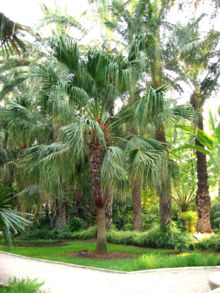Livistona chinensis: Difference between revisions
mNo edit summary |
No edit summary |
||
| Line 10: | Line 10: | ||
|familia = [[Arecaceae]] |
|familia = [[Arecaceae]] |
||
|genus = ''[[Livistona]]'' |
|genus = ''[[Livistona]]'' |
||
|species = ''''' |
|species = '''''chinensis''''' |
||
|binomial = ''Livistona chinensis'' |
|binomial = ''Livistona chinensis'' |
||
|binomial_authority = (Jacquin) R. Brown ex Martius in C. F. P. von Martius et al. |
|binomial_authority = (Jacquin) R. Brown ex Martius in C. F. P. von Martius et al. |
||
Revision as of 06:55, 6 March 2017
| Fountain palm Chinese fan palm | |
|---|---|

| |
| Scientific classification | |
| Kingdom: | |
| (unranked): | |
| (unranked): | |
| (unranked): | |
| Order: | |
| Family: | |
| Genus: | |
| Species: | chinensis
|
| Binomial name | |
| Livistona chinensis (Jacquin) R. Brown ex Martius in C. F. P. von Martius et al.
| |
Livistona chinensis, the Chinese fan palm or fountain palm, is a species of subtropical palm tree in eastern Asia. It is native to Southern Japan, Taiwan, the Ryukyu Islands, and the Guangdong region of southern China. It is also reportedly naturalized in South Africa, Mauritius, Réunion, the Andaman Islands, Java, New Caledonia, Micronesia, Hawaii, Florida, Bermuda, Puerto Rico and the Dominican Republic.[1][2]
Livistona chinensis can attain heights of about 9 to 15 m (30 to 50 ft) and a spread of 4 m (12 ft). The leaves are fan shaped.
Cultivation
The palm is cultivated as ornamental trees in gardens and conservatories.
This plant can become a weed, or in some ecosystems an invasive species – such as in Florida wetlands and on some Caribbean Islands.
References
- Bermuda Department of Conservation Services: Invasive Species Profile for Chinese Fan Palm
External links
